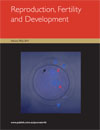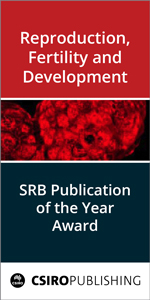Reproduction, Fertility and Development
Volume 29
Number 2 2017
Oocyte quality is critical for female reproduction. Using a pig oocyte model, this study revealed the important role of mitogen-activated protein kinase-activated kinase (MK2) in regulating meiotic resumption and spindle organization, as well as euploid oocyte production. This will contribute to understanding the causes of female infertility and improving the success of assisted reproduction.
The mechanisms underlying follicle selection in monovular species are largely unknown. We assessed the involvement of FGF7 subfamily members in follicle selection in cattle and found that expression of ligands and receptors is upregulated in subordinate vs dominant follicles during follicle deviation, and that FGF10 inhibits oestradiol secretion and expression of FSHR and IGF1R in granulosa cells. These data point to an important role for FGF10 in follicle selection.
Scrotal ultrasonography can be employed to study testicular development but echotextural characteristics of specific germ cell types remain unknown. Retinoic acid (RA) given to prepubescent ram lambs reduced the variation in germ cell populations, which corresponded with a significant change in numerical pixel values (brightness) of the testicular parenchyma. RA manipulation of spermatogenic function, particularly in sexually immature animals, may provide a useful model for further investigations into the non-invasive ultrasonographic monitoring of spermatogenesis.
Studies on subsequent reproductive performance of low birth weight gilts are limited. The effects of birth weight on the development of the reproductive tract and puberty onset were investigated herein, and both parameters seem equivalent in different birth weight gilts. As birth weight may be an important parameter to include in dam line breeding programs, a better understanding of the impact of birth weight on fertility seems critical.
This study aims to understand the complex dynamics of dog folliculogenesis through in vitro studies. This study demonstrates that both preantral and early antral stage follicle grow significantly in vitro with FSH, but not LH, being a key regulator. The findings serve as important foundation for the establishment of in vitro follicle culture system for rescuing maternal genomes in domestic and wild canids.
We examined the global gene expression profile of endometrial tissue on Day 7 of the oestrous cycle in Holstein cows with good or poor genetic merit for fertility traits. Three physiologically relevant networks of genes were identified: (1) actin and cytoskeletal components; (2) immune function; and (3) ion transportation. This study has identified three important areas for future research.
Reduced glutathione (GSH) improves the fertilising ability of frozen–thawed boar spermatozoa. The present study investigated the relationship between acrosin activity and reproductive performance in frozen–thawed boar spermatozoa and the effects of GSH. The results show that GSH counteracts the decrease in acrosin activity in good but not poor freezability ejaculates and suggest that the increase in reproductive performance mediated by GSH could be related to acrosin activity.
The whooping crane underwent a severe genetic bottleneck in the early 1940s. The present study demonstrates that time of breeding season, but not inbreeding coefficient, affects the seminal characteristics of cranes maintained ex situ. The findings will serve as an important foundation for efforts in incorporating AI with frozen–thawed semen into genetic and demographic management of this endangered species.
Growth restriction increases the risk of developing disease in adulthood, with the postnatal environment playing a critical role. This study identified the effects of prenatal and postnatal growth restriction on puberty onset and metabolism in growth restricted rats. The results show that growth restricted males and females had a delayed puberty onset, with altered sex-hormone concentrations and reduced leptin. Improvement of postnatal nutrition leads to a restoration of plasma leptin concentrations and rectification of the timing of puberty onset.
Being able to induce meiotic arrest, C-type natriuretic peptide (CNP) provides a new alternative to improve the synchronisation of nuclear and cytoplasmic maturation of oocytes matured in vitro. In the present study, temporary meiotic arrest induced by CNP significantly improved maturation and the subsequent development of mouse immature oocytes in vitro. These results indicate the potential value of CNP in improving the efficiency of oocyte IVM.
The maternal diet can alter the bodyweight and immune programming of subsequent generations. A maternal hypercaloric diet (HD) during puberty and early adult age induces overweight in the F1 generation and increases peripheral inflammation despite the feeding of a normocaloric diet to the F1 generation. It also induces adaptative patterns of the hypothalamic glial response towards a state of neuroprotection. These data reveal a transgenerational effect of the HD that may occur, in part, through permanent changes in immune and nervous system programming.
Aquaporins (AQPs) play an important role in fluid homeostasis in epithelia. To understand oviductal fluid homeostasis, AQP5 expression was examined in immature and cycling female mice. In oviduct epithelia, AQP5 in non-ciliated cells was increased by gonadotropin in immature mice and peaked during oestrus in cycling females, suggesting its participation in fluid homeostasis in oviduct epithelia.
For the first time in a marsupial species, this study visually revealed that spermatozoa of the tammar wallaby can be quickly induced into a hyperactivated pattern, a necessary condition that enables spermatozoa to fertilise eggs in nature. The study also identified that BWW medium is able to maintain sperm motility, metabolism and viability better than other commonly used media. As there has been no success with IVF in any marsupials so far, this information could enable researchers to develop a proper IVF protocol for endangered marsupial species.
The gene expression pattern varies between porcine embryos produced by different methods and to analyse these changes normalisation against reference genes is routinely employed. However, these reference genes should be carefully chosen for evaluation as they also tend to have variable expression. In our study using three different analysis programs, we determined that SDHA and H2A are the most-stable reference genes that can be used for accurate normalisation to obtain reliable results.
The presence of two canine fetuses within one placental site has been rarely documented in the literature. In this case report, we describe the finding of monochorionic canine fetuses of discordant gender, with co-mingling of the fetal blood supplies. Abnormal sexual development was discovered in both fetuses, which, in the female, resembles freemartinism, a phenomenon not previously reported in this species.
The reproductive performance of offspring in adulthood is determined during fetal and neonatal development. The aim of the present study was to explore the effect of intra-uterine growth restriction on the reproductive performance of offspring. Growth restriction affected sperm production via reproductive organ development and epigenetic regulation. These results provide evidence for the effects of prenatal development on programming reproductive performance in male offspring.
The ultrastructure of the spermatogenesis in agoutis help to identify the processes that affect infertility and the use of biotechnologies related to reproduction. The Leydig and Sertoli cells undergo morpho-physiological changes during sexual development, especially in the prepubertal phase. The spermatozoon of agouti had a tapered head without prominence of the acrosome and no evidence of the perforatorium. There is evidence of degeneration of centrioles in completely formed spermatozoa. In order to deepen the knowledge on spermatogenesis of agouti kept in captivity, this work highlights the importance of reproduction in wild species for their preservation and rational creation.
Seminal plasma proteins (SPP) support survival of ram spermatozoa, exerting a dual effect, both capacitating and decapacitating. The addition of SPP before in vitro capacitation with epidermal growth factor induced a decrease in progressive spermatozoa and an increase in hyperactivated spermatozoa. Ram spermatozoa are able to undergo capacitation with no hyperactivation and SPP are able to induce hyperactivation in spermatozoa but maintain them in a decapacitated state.
Could a supplement hold the key to understanding the mechanism of progesterone production by the postovulatory cumulus-oocyte complexes (COCs)? In the research various supplements influencing progesterone production by rat COCs containing unfertilised or fertilised oocytes have been tested in vitro, suggesting that the hormone mixture of prolactin and testosterone increased progesterone synthesis and oocyte fertilisability. This might prompt a wider research on the use of this mixture to increase the IVF success rates also in other species.
In vitro embryo culture is gaining popularity in various species as a means for generating pregnancies. In this study, supplementing culture medium with uterine-derived factors improved bovine placental cell proliferation and embryo development. These findings support the contention that providing selective uterine-derived factors during early embryo culture improves embryo competency for maintaining viable pregnancies and producing healthy offspring.




